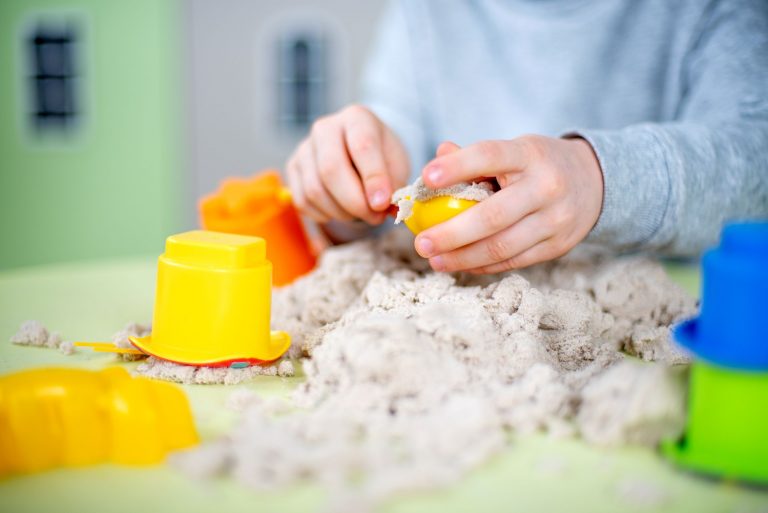Kinetic Sand for Special Needs Children
Sand is a popular medium that children love to play with. It provides a unique tactile experience that is both fun and interactive. Kinetic sand, in particular, is a new and innovative type of sand that has become increasingly popular, particularly within therapeutic settings for children with various special needs. Let’s learn about kinetic sand and explore its benefits for special needs children, especially on how it can improve their sensory, communication and cognitive abilities, motor skills, and provide stress relief. We will explore different examples of how kinetic sand has been used in therapy settings, and learn about the safety measures required for its proper usage.


What is Kinetic Sand?
Kinetic sand is a unique type of sand that has been specifically designed to stick together, making it more moldable and interactive than regular sand. It’s made from 98% real sand and 2% polymer, which gives it its unique properties. Unlike regular sand, kinetic sand doesn’t dry out, and it doesn’t leave any residue on hands, clothes, or surfaces. It’s also hypoallergenic, making it safe for children with allergies.
The Benefits of Kinetic Sand for Special Needs Children
Kinetic sand has been used as an effective therapy tool for children with various special needs, particularly those with sensory processing, communication, and cognitive disorders.
Sensory Stimulation: One of the most significant benefits of kinetic sand is its ability to provide sensory stimulation. It’s a tactile medium that can help children who are under-responsive to sensory input or who may have aversions to textures. The unique properties of kinetic sand can help children regulate their sensory input, which can lead to improved behavior, attention, and engagement.
Communication Skills: Kinetic sand can also help enhance communication skills. Children can use the sand to create shapes, write letters or numbers, or create symbol representations. This can help children with communication disorders to practice expressing themselves and better understand language concepts.
Cognitive Development: By playing with kinetic sand, children can also improve their cognitive skills, particularly those related to problem-solving, creativity, and imagination. The sand allows them to experiment with different shapes, sizes, and textures, which can help develop spatial awareness and attention to detail.
Fine Motor Skills: Kinetic sand can also help improve fine motor skills, particularly those related to hand-eye coordination and finger strength. Children can use their fingers to create different shapes, developing the muscles in their hands and fingers.
Stress Relief: Kinetic sand can help children with special needs cope with stress and anxiety. It’s an effective stress-relief tool that allows children to relax and focus on their senses.
How Kinetic Sand is Used in Therapy Settings
Kinetic sand can be used in various ways within therapy settings to engage and support children with special needs. Here are a few examples:
As a calming tool: Kinetic sand can help calm children who may be feeling overwhelmed or stressed. By providing a tactile, sensory experience, the sand can help children regulate their emotions, leading to better behavior and attention.
To improve motor skills: By manipulating the sand, children can develop the muscles in their hands and fingers, improving their fine motor skills. Therapists can use kinetic sand to encourage various hand movements or hand-eye coordination.
For communication practice: Kinetic sand can be used as an interactive tool to encourage communication. Children can practice articulating concepts or ideas by creating shapes or objects with the sand.
As a reward system: Kinetic sand can be an effective reward system for children who have met specific goals or targets during therapy sessions. This can motivate children to engage and participate in their therapy sessions.
Safety Measures
While kinetic sand is safe and hypoallergenic, there are some safety measures that therapists and caregivers should consider when using kinetic sand in therapy settings. First, ensure that the sand is free from any contaminants or debris that could pose a choking hazard. Additionally, it’s essential to monitor children to ensure that they do not ingest the sand. If this happens, seek medical attention immediately. Finally, remember to store the sand in suitable containers to prevent it from attracting unwanted critters or getting contaminated.
Conclusion
Kinetic sand is a unique therapy tool that has significant benefits for children with special needs. It provides a tactile, sensory experience that can help improve sensory, communication, and cognitive abilities, motor skills, and provide stress relief. There are various ways that kinetic sand can be used in therapy settings to support children with various special needs. Therapists and caregivers should take appropriate safety measures to ensure proper usage. By incorporating kinetic sand in therapy sessions, parents, therapists and caregivers can improve the experience for children with sensory and communication disorders.
